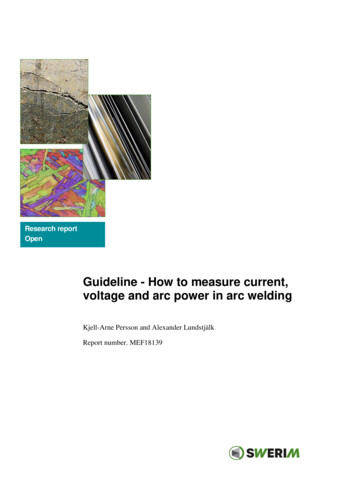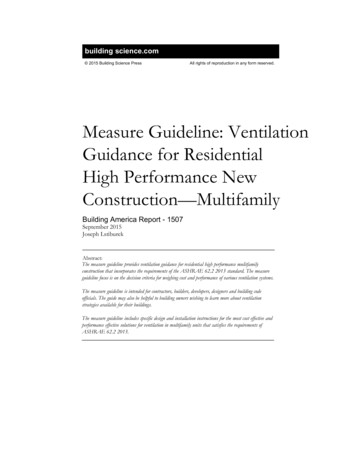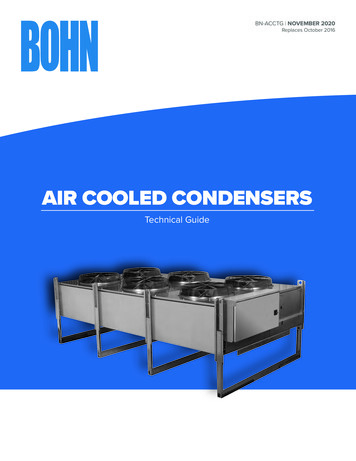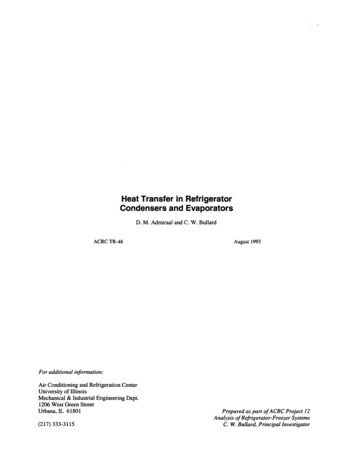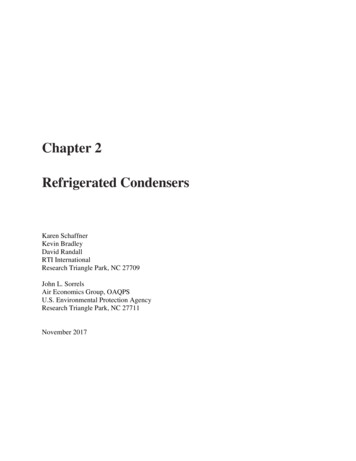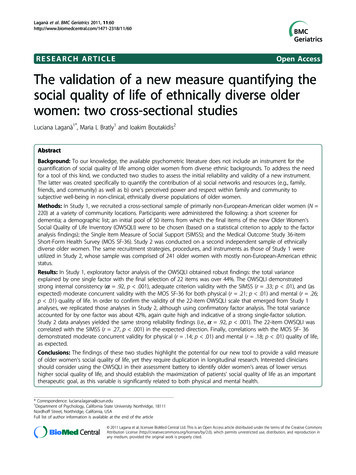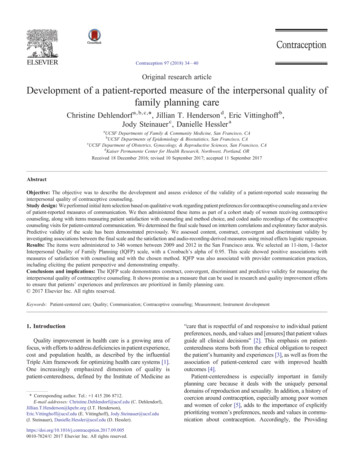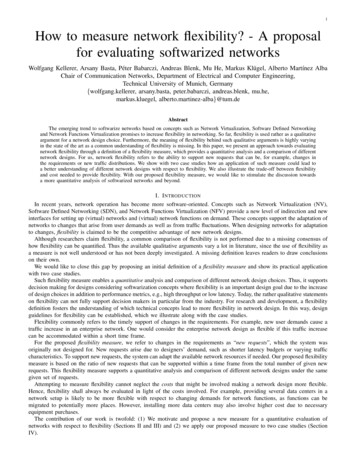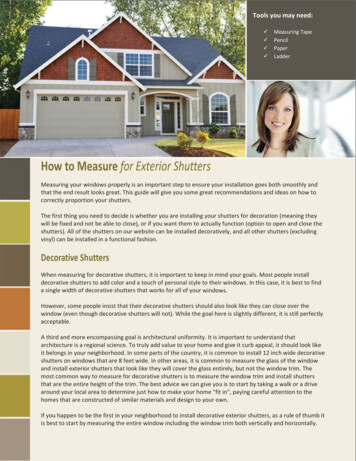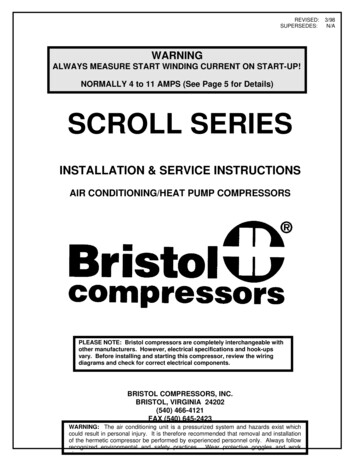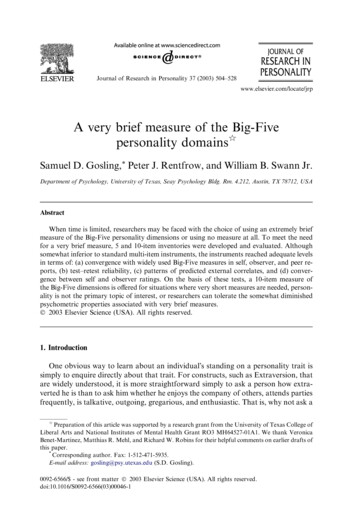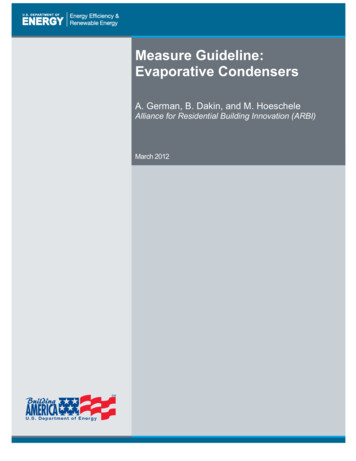
Transcription
Measure Guideline:Evaporative CondensersA. German, B. Dakin, and M. HoescheleAlliance for Residential Building Innovation (ARBI)March 2012
NOTICEThis report was prepared as an account of work sponsored by an agency of theUnited States government. Neither the United States government nor any agencythereof, nor any of their employees, subcontractors or affiliated partners makes anywarranty, express or implied, or assumes any legal liability or responsibility for theaccuracy, completeness, or usefulness of any information, apparatus, product, orprocess disclosed, or represents that its use would not infringe privately owned rights.Reference herein to any specific commercial product, process, or service by tradename, trademark, manufacturer, or otherwise does not necessarily constitute or implyits endorsement, recommendation, or favoring by the United States government orany agency thereof. The views and opinions of authors expressed herein do notnecessarily state or reflect those of the United States government or any agencythereof.Available electronically at http://www.osti.gov/bridgeAvailable for a processing fee to U.S. Department of Energyand its contractors, in paper, from:U.S. Department of EnergyOffice of Scientific and Technical InformationP.O. Box 62Oak Ridge, TN 37831-0062phone: 865.576.8401fax: 865.576.5728email: mailto:reports@adonis.osti.govAvailable for sale to the public, in paper, from:U.S. Department of CommerceNational Technical Information Service5285 Port Royal RoadSpringfield, VA 22161phone: 800.553.6847fax: 703.605.6900email: orders@ntis.fedworld.govonline ordering: http://www.ntis.gov/ordering.htmPrinted on paper containing at least 50% wastepaper, including 20% postconsumer waste
Measure Guideline: Evaporative CondensersPrepared for:Building AmericaBuilding Technologies ProgramOffice of Energy Efficiency and Renewable EnergyU.S. Department of EnergyPrepared by:A. German, B. Dakin, M. HoescheleAlliance for Residential Building Innovation (ARBI)Davis Energy Group, Team Lead123 C StreetDavis, California 95616NREL Technical Monitor: Michael GestwickPrepared under Subcontract No. KNDJ-0-40340-00March, 2012iii
[This page left blank]iv
ContentsList of Figures . viList of Tables . viiDefinitions . viiiExecutive Summary . ixAcknowledgements . ixSection 1:Section 2:Introduction . 1Measure Selection Criteria . 32.1 Technology Description .32.2 Measure Tradeoffs and Non-Energy Benefits .42.3 System Interactions .52.4 Performance Characterization .52.5 Appliance Design .72.6 Costs .82.7 Energy Savings and Cost Effectiveness .10Section 3:Measure Implementation Details . 183.1 Field Inspection .183.2 System Design and Site Preparation .193.3 Installation Prodecure .193.4 Verification Procedures and Tests .213.5 Operation and Maintenance .22Attachment A: Prescriptive Measure Checklist for Contractors . 24Attachment B: Modeling Methodology and Detail . 25Attachment C: Additional Modeling Results . 27References . 29v
List of FiguresFigure 1: Evaporative condenser operation schematic . 3Figure 2: Performance characterization of air-cooled and evaporative cooled condensers over arange of outdoor dry bulb temperatures . 7Figure 3: Example of condenser coil configuration to allow for adequate drainage of liquidrefrigerant . 7Figure 4: Condenser coil before (left) and after (right) prolonged operation without any watermanagement strategies . 9Figure 5: Building America and IECC climate zone reference map . 11Figure 6: Annual cooling energy comparison of air-cooled and evaporative cooled condensersover a range of rated EER in a hot-dry climate . 13Figure 7: Full load condenser EER (Btu/wh) (no indoor fan energy) versus both outdoor andentering wet-bulb temperatures (WB F) . 17Figure 8: Float to adjust water sump level . 20Figure 9: Gauges connected to operating evaporative condenser to verify correct charge . 21Figure 10: Water sump and pump filter basket during operation . 23Unless otherwise noted, all figures were created by the ARBI team.vi
List of TablesTable 1: Annual Cooling Energy Savings Compared to a SEER 13 Air Conditioner . 12Table 2: Annual Cooling Energy Savings Compared to a SEER 15 Air Conditioner . 12Table 3: Incremental Cost Justified by Energy Modeling Savings Compared to a SEER 13 AirConditioner for Various Interest Rate Financing Scenarios . 14Table 4: Incremental Cost Justified by Energy Modeling Savings Compared to a SEER 15 AirConditioner for Various Interest Rate Financing Scenarios . 14Table 5: Minimum Annual Cooling UtilityBill to Justify Evaporative Condensers under VariousPayback Scenarios Based on a Mature Market Incremental Cost of 750 over a SEER 13 AirConditioner. 15Table 6: Minimum Annual Cooling Utility Bill to Justify Evaporative Condensers under VariousPayback Scenarios Based on a Mature Market Incremental Cost of 350 over a SEER 15 AirConditioner. 15Table 7: New Construction Assumptions by Climate Zone . 25Table 8: Existing Home Assumptions by Building Vintage . 26Table 9: Annual Cooling Energy Savings Compared to an Existing Home Circa 1980 with a SEER13 Air Conditioner. 27Table 10: Annual Cooling Energy Savings Compared to an Existing Home Circa 1980 with a SEER15 Air Conditioner. 27Table 11: Annual Water Operating Costs for Evaporative Condenser Assuming National AverageWater Rates . 28Table 12: Incremental Cost Justified by Energy Modeling Savings Compared to a SEER 13 AirConditioner for Various Interest Rate Financing Scenarios – Includes Both Energy UtilitySavings and Additional Water Costs . 28Table 13: Incremental Cost Justified by Energy Modeling Savings Compared to a SEER 15 AirConditioner for Various Interest Rate Financing Scenarios – Includes Both Energy UtilitySavings and Additional Water Costs . 28Unless otherwise noted, all tables were created by the ARBI team.vii
DefinitionsACAir conditionerACCAAir Conditioning Contractors of AmericaAFUEAnnual Fuel Utilization Efficiency – Seasonal efficiency forresidential gas furnacesAHRIAir-Conditioning, Heating, and Refrigeration InstituteARBIAlliance for Residential Building InnovationBtuBritish thermal unitCARBConsortium for Advanced Residential BuildingsCECCalifornia Energy CommissioncfmCubic feet per minuteDEGDavis Energy GroupoDegrees FahrenheitECEvaporative condenserEEREnergy Efficiency RatioEIRElectric input ratioHSPHouse Simulation ProtocolsHVACHeating, ventilation, and air conditioningkWKilowattkWhKilowatt-hourSHGCSolar heat gain coefficientSMUDSacramento Municipal Utility DistrictPG&EPacific Gas and Electric CompanyRECSResidential Energy Consumption SurveySCESouthern California EdisonSEERSeasonal Energy Efficiency RatioTXVThermostatic expansion valveWWattZNEZero net energyFviii
Executive SummaryThe purpose of this measure guideline on evaporative condensers is to provide information on acost-effective solution for energy and demand savings in homes with cooling loads. This is aprescriptive approach that outlines selection criteria, design and installation procedures, andoperation and maintenance best practices. This document has been prepared to provide a processfor properly designing, installing, and maintaining evaporative condenser systems as well asunderstanding the benefits, costs, and tradeoffs. The primary audience for this document includesthe following: HVAC contractors Builders Remodelers.As a secondary audience, homeowners who have a basic understanding of HVAC systems willalso benefit from the information contained within.Evaporative cooling has been used successfully throughout history to provide cooling and isespecially effective in hot-dry climates. The use of evaporative processes to improve coolingefficiency is an important vehicle for reducing energy use and peak demand in hot-dry climates.Direct space cooling through evaporative cooling does not provide the same quality of comfortas compressor-based processes in that for most technologies moisture is added rather thanremoved from the air. While this may be acceptable in dry climates it is not in humid climateswhere air conditioning is relied upon not only for sensible cooling but for dehumidification.Evaporative condensers utilize the high efficiency of evaporative cooling at the condensing unit,while also providing dehumidification identical to a conventional air conditioning system.Evaporative condensers may play a key role in meeting Building America performance goals innew homes, and also in existing homes that have high loads due to sub-standard wall insulationand windows, that are much more costly to upgrade.AcknowledgementsDavis Energy Group would like to acknowledge the United States Department of EnergyBuilding America program and their funding and support of development of this guideline aswell as research that informed it. We also thank Western Cooling Efficiency Center at theUniversity of California, Davis for their research and contribution to this measure guideline. Inaddition, we would like to acknowledge Pacific Gas and Electric, Southern California Edisonand the Sacramento Municipal Utility District for their previous research efforts that havecontributed to the large body of information on evaporative condensers and have supportedproduct development.ix
Section 1: IntroductionResidential air conditioning has become increasingly common throughout the United States overthe past 30 years as comfort demands have increased and market demands have pushedcompressor-based cooling into climates not previously seen. Increasingly, air conditioners arebeing installed in milder, transitional climates to compensate for these increased comfortdemands, as well as increased building loads seen from the trend towards larger homes andgreater window areas. The 2009 Residential Energy Consumption Survey (RECS) shows that61% of residential homes have central air conditioning. This is up significantly from 47% in1997 and only 23% in 1978 1.Evaporative cooling has been used successfully throughout history to provide cooling and isespecially effective in hot-dry climates. The use of evaporative processes to improve coolingefficiency is an important vehicle for reducing energy use and peak demand in hot-dry climates.Direct space cooling through evaporative cooling does not provide the same quality of comfortas compressor-based processes in that for most technologies, moisture is added rather thanremoved from the air. While this may be acceptable in dry climates, it is not in humid climateswhere air conditioning is relied upon not only for sensible cooling but for dehumidification.Evaporative condensers (ECs) utilize the efficiency of evaporative cooling to cool enteringcondenser air at the condensing unit, while also providing dehumidification identical to aconventional air conditioning system. Evaporative condensers may play a key role in meetingBuilding America performance goals in new homes, and also in existing homes that have highloads due to sub-standard wall insulation and windows, that are much more costly to upgrade.The purpose of this measure guideline on evaporative condensers is to provide information on acost-effective solution for energy and demand savings in homes with cooling loads. Thisdocument outlines system tradeoffs including a discussion of selection criteria, systemperformance, energy and cost savings, design and installation procedures, and operation andmaintenance best practices. The primary audience for this document includes contractors,builders, and remodelers with certain information also applicable to homeowners.Previous research has demonstrated the efficiency benefits of evaporative condensers. DavisEnergy Group (DEG) has completed simulations and laboratory and field testing of a variety ofevaporative condensers. With Building America support, a Freus unit was field tested in theSouthern California desert town of Borrego Springs in 2006 and 2007 (Springer et al, 2008).Performance results showed significant energy savings over standard air-cooled condensingequipment. During 2009, DEG worked with Beutler Corporation (manufacturer of the AquaChillevaporative condenser) to assess AquaChill design and performance, and help set up their inhouse test facility. Potential enhancements were identified with the help of a refrigerationengineer and design variations were tested. Condenser coil and other design improvements wereincorporated into the “second generation” system and lab testing of this design showed improvedperformance over the previous version, with a 15 EER rating at AHRI conditions (75 F outdoorwet bulb temperature). These results are also summarized in The Consortium of AdvancedResidential Buildings’ (CARB) Building America 2009 annual report (CARB, 2009). Lab testingof a production AquaChill unit was also completed by Southern California Edison (SCE, cs/actrends/recs ac trends.html1
and reported an EER of 13.5 at AHRI conditions, but applied actual fan energy use instead of adefault value.In December 1998, Davis Energy Group (DEG, 1998) completed an evaluation of residentialevaporative condensers that involved evaluation of two EC designs including: evaluating testdata from Pacific Gas & Electric’s (PG&E) Technical and Ecological Services (TES) laboratory,developing DOE-2 performance curves based on the lab test data, estimating EC savings usingDOE-2 and the developed curves, and field testing of ECs. In the summer of 2007, Davis EnergyGroup evaluated two residential Freus installations for a PG&E technology evaluation report(DEG, 2008). Monitoring data from the sites were used to develop a performance algorithmusing MicroPas hourly loads. Simulation projections suggest 21%-33% annual cooling energysavings and 22%-35% coincident peak cooling demand savings in typical Central Valleyapplications.During the summer of 2009, the Sacramento Municipal Utility District (SMUD) worked withADM Associates to complete monitoring and field evaluation of 26 AquaChill units (Keesee etal, 2010). The data was analyzed and compared to usage data for typical residential homes inSMUD territory. Findings from the study include that air conditioning energy use can be reducedby 29% for a typical single family home in SMUD territory and peak power can be potentiallyreduced 23% compared to a typical single family 4-ton unit.The improved “second generation” AquaChill was installed and instrumented at an existing,occupied home in Davis, California, in September, 2010, and was monitored through the 2011summer (ARBI, 2011). Results showed an average measured condenser EER of 17. In 2010,DEG conducted a study for PG&E to evaluate evaporatively cooled condensers as a potentialcomponent of a Zero Net Energy (ZNE) strategy for new and existing homes (DEG, 2010). Theresults of the study showed that evaporative condensers have significant benefits and can be costeffective in hot-dry climates where cooling energy use is significant.2
Section 2: Measure Selection Criteria2.1 Technology DescriptionEvaporative condensers (ECs) operate by rejecting condenserheat to a water sump that is cooled by the evaporation ofwater. They replace the fin-tube air-cooled condenser coil witha refrigerant-to-water copper heat exchanger that isevaporatively cooled. ECs cool the refrigerant by sprayingwater on the condenser coils during operation, resulting inlower condensing temperatures, reducing demand, andpotentially improving utility load factor because the increasedefficiency is most pronounced during peak demand p
Table 2: Annual Cooling Energy Savings Compared to a SEER 15 Air Conditioner . 12 Table 3: Incremental Cost Justified by Energy Modeling Savings Compared to a SEER 13 Air . With Building America support, a Freus unit was field tested in the Southern California desert town of
